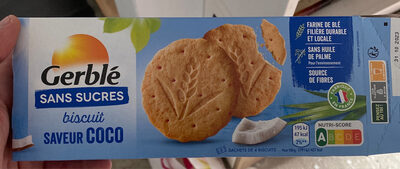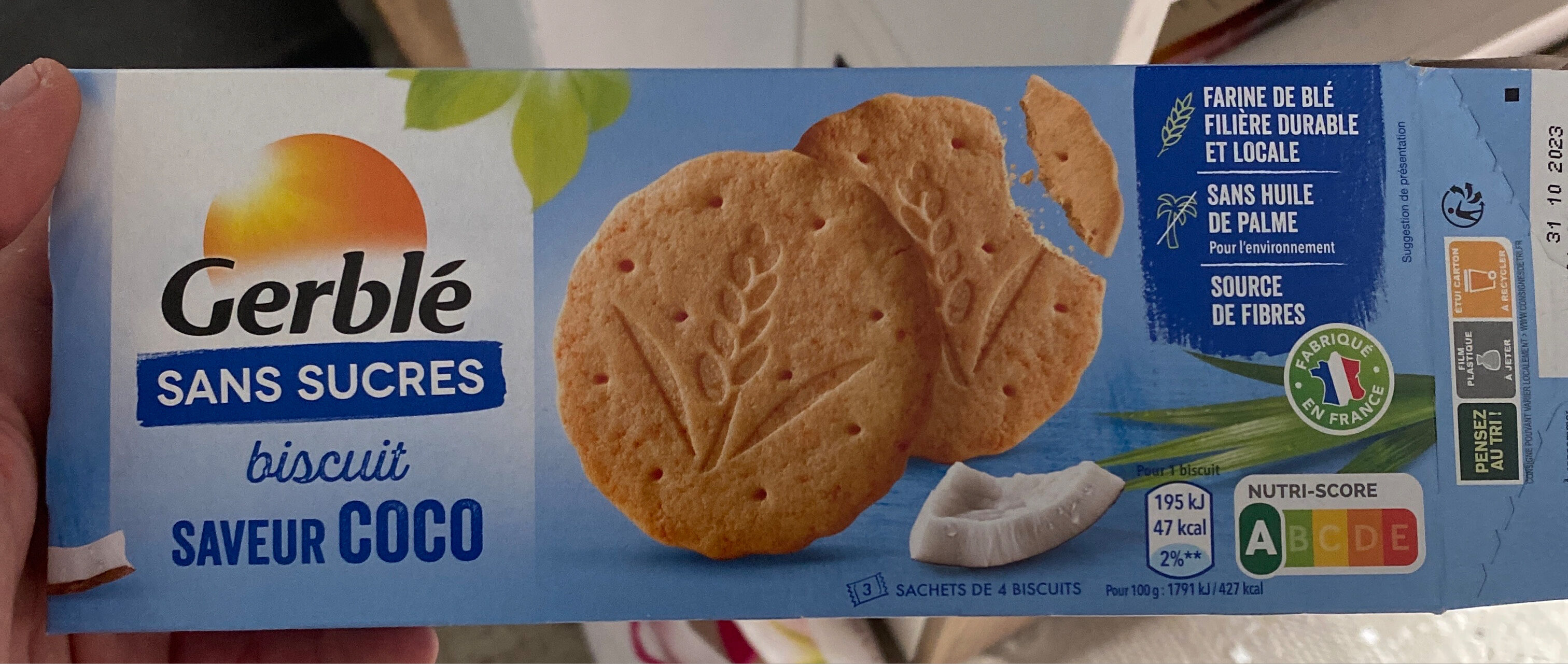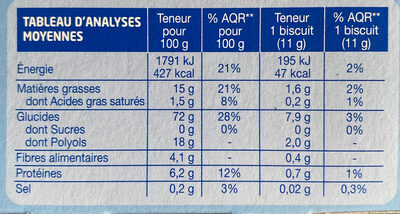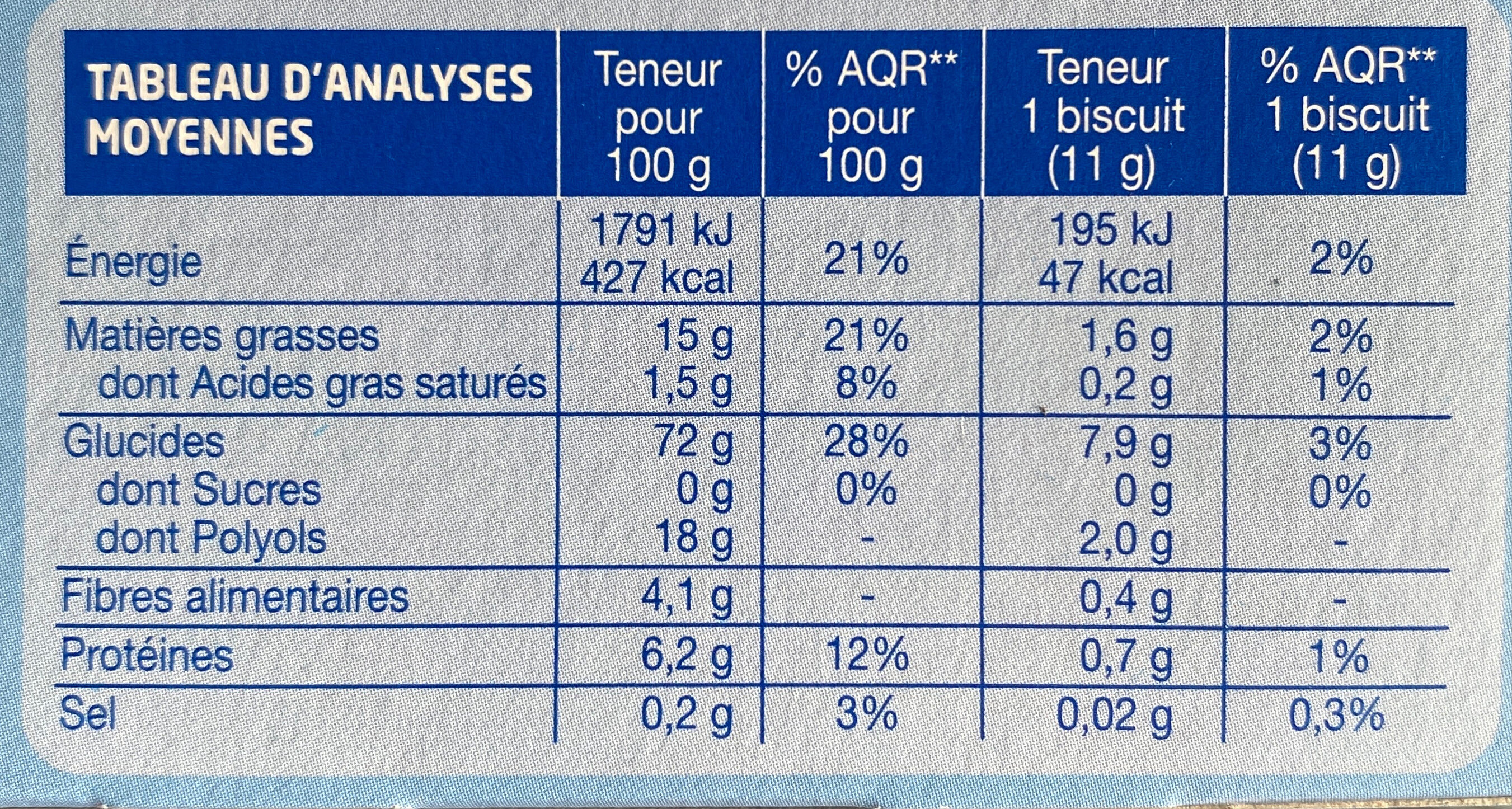Help us make food transparency the norm!
As a non-profit organization, we depend on your donations to continue informing consumers around the world about what they eat.
The food revolution starts with you!
Biscuit Coco - Gerblé - 132 g
Biscuit Coco - Gerblé - 132 g
This product page is not complete. You can help to complete it by editing it and adding more data from the photos we have, or by taking more photos using the app for Android or iPhone/iPad. Thank you!
×
บาร์โค้ด: 3175681116832 (EAN / EAN-13)
ปริมาณ: 132 g
บรรจุภัณฑ์: en:Plastic, en:Cardboard, fr:Etui en carton, fr:Sachet en plastique
ยี่ห้อสินค้า: Gerblé
หมวดหมู่: ขนม-ของว่าง, en:Sweet snacks, ขนมปังกรอบและเค๊ก, บิสกิต, เค้ก, en:Dry biscuits, en:Biscuit with reduced sugar
ฉลากต่างๆ การรับรอง และรางวัล:
น้ำตาลต่ำ, กรีนดอท, en:Made in France, ไม่เติมสี, ไม่ใช้น้ำมันปาล์ม, ไม่มีน้ำตาล, Nutriscore, Nutriscore A, ใช้น้ำตาลเทียม, Triman, fr:Glucoregul

สถานที่ผลิตหรือแปรรูป: France
ร้านค้า: Carrefour, Magasins U, carrefour.fr
ประเทศที่ขาย: ประเทศเบลเยียม, ประเทศฝรั่งเศส, ประเทศไทย (Thai)
Matching with your preferences
Health
ส่วนผสม
-
12 ingredients
: Farine de blé 58,1%, édulcorant : maltitols d'origine végétale, huile de colza, amidon de blé, fibres de blé, arômes naturels, émulsifiant : lécithines de colza, sel de mer, poudres à lever (acide citrique, carbonates d'ammonium).สารก่อภูมิแพ้: กลูเต็นTraces: ไข่, ลูพิน, นม, อัลมอนด์, ถั่วเหลือง
Food processing
-
Ultra processed foods
Elements that indicate the product is in the en:4 - Ultra processed food and drink products group:
- สารปรุงแต่งอาหาร: E322
- สารปรุงแต่งอาหาร: E965
- Ingredient: Emulsifier
- Ingredient: Flavouring
- Ingredient: Sweetener
Food products are classified into 4 groups according to their degree of processing:
- Unprocessed or minimally processed foods
- Processed culinary ingredients
- Processed foods
- Ultra processed foods
The determination of the group is based on the category of the product and on the ingredients it contains.
สารปรุงแต่งอาหาร
-
E322
Lecithin: Lecithin -UK: , US: , from the Greek lekithos, "egg yolk"- is a generic term to designate any group of yellow-brownish fatty substances occurring in animal and plant tissues, which are amphiphilic – they attract both water and fatty substances -and so are both hydrophilic and lipophilic-, and are used for smoothing food textures, dissolving powders -emulsifying-, homogenizing liquid mixtures, and repelling sticking materials.Lecithins are mixtures of glycerophospholipids including phosphatidylcholine, phosphatidylethanolamine, phosphatidylinositol, phosphatidylserine, and phosphatidic acid.Lecithin was first isolated in 1845 by the French chemist and pharmacist Theodore Gobley. In 1850, he named the phosphatidylcholine lécithine. Gobley originally isolated lecithin from egg yolk—λέκιθος lekithos is "egg yolk" in Ancient Greek—and established the complete chemical formula of phosphatidylcholine in 1874; in between, he had demonstrated the presence of lecithin in a variety of biological matters, including venous blood, in human lungs, bile, human brain tissue, fish eggs, fish roe, and chicken and sheep brain. Lecithin can easily be extracted chemically using solvents such as hexane, ethanol, acetone, petroleum ether, benzene, etc., or extraction can be done mechanically. It is usually available from sources such as soybeans, eggs, milk, marine sources, rapeseed, cottonseed, and sunflower. It has low solubility in water, but is an excellent emulsifier. In aqueous solution, its phospholipids can form either liposomes, bilayer sheets, micelles, or lamellar structures, depending on hydration and temperature. This results in a type of surfactant that usually is classified as amphipathic. Lecithin is sold as a food additive and dietary supplement. In cooking, it is sometimes used as an emulsifier and to prevent sticking, for example in nonstick cooking spray.Source: Wikipedia (ภาษาอังกฤษ)
-
E322i - เลซิทิน
Lecithin: Lecithin -UK: , US: , from the Greek lekithos, "egg yolk"- is a generic term to designate any group of yellow-brownish fatty substances occurring in animal and plant tissues, which are amphiphilic – they attract both water and fatty substances -and so are both hydrophilic and lipophilic-, and are used for smoothing food textures, dissolving powders -emulsifying-, homogenizing liquid mixtures, and repelling sticking materials.Lecithins are mixtures of glycerophospholipids including phosphatidylcholine, phosphatidylethanolamine, phosphatidylinositol, phosphatidylserine, and phosphatidic acid.Lecithin was first isolated in 1845 by the French chemist and pharmacist Theodore Gobley. In 1850, he named the phosphatidylcholine lécithine. Gobley originally isolated lecithin from egg yolk—λέκιθος lekithos is "egg yolk" in Ancient Greek—and established the complete chemical formula of phosphatidylcholine in 1874; in between, he had demonstrated the presence of lecithin in a variety of biological matters, including venous blood, in human lungs, bile, human brain tissue, fish eggs, fish roe, and chicken and sheep brain. Lecithin can easily be extracted chemically using solvents such as hexane, ethanol, acetone, petroleum ether, benzene, etc., or extraction can be done mechanically. It is usually available from sources such as soybeans, eggs, milk, marine sources, rapeseed, cottonseed, and sunflower. It has low solubility in water, but is an excellent emulsifier. In aqueous solution, its phospholipids can form either liposomes, bilayer sheets, micelles, or lamellar structures, depending on hydration and temperature. This results in a type of surfactant that usually is classified as amphipathic. Lecithin is sold as a food additive and dietary supplement. In cooking, it is sometimes used as an emulsifier and to prevent sticking, for example in nonstick cooking spray.Source: Wikipedia (ภาษาอังกฤษ)
-
E330
Citric acid: Citric acid is a weak organic acid that has the chemical formula C6H8O7. It occurs naturally in citrus fruits. In biochemistry, it is an intermediate in the citric acid cycle, which occurs in the metabolism of all aerobic organisms. More than a million tons of citric acid are manufactured every year. It is used widely as an acidifier, as a flavoring and chelating agent.A citrate is a derivative of citric acid; that is, the salts, esters, and the polyatomic anion found in solution. An example of the former, a salt is trisodium citrate; an ester is triethyl citrate. When part of a salt, the formula of the citrate ion is written as C6H5O3−7 or C3H5O-COO-3−3.Source: Wikipedia (ภาษาอังกฤษ)
-
E503
Ammonium carbonate: Ammonium carbonate is a salt with the chemical formula -NH4-2CO3. Since it readily degrades to gaseous ammonia and carbon dioxide upon heating, it is used as a leavening agent and also as smelling salt. It is also known as baker's ammonia and was a predecessor to the more modern leavening agents baking soda and baking powder. It is a component of what was formerly known as sal volatile and salt of hartshorn.Source: Wikipedia (ภาษาอังกฤษ)
-
E965
Maltitol: Maltitol is a sugar alcohol -a polyol- used as a sugar substitute. It has 75–90% of the sweetness of sucrose -table sugar- and nearly identical properties, except for browning. It is used to replace table sugar because it is half as caloric, does not promote tooth decay, and has a somewhat lesser effect on blood glucose. In chemical terms, maltitol is known as 4-O-α-glucopyranosyl-D-sorbitol. It is used in commercial products under trade names such as Lesys, Maltisweet and SweetPearl.Source: Wikipedia (ภาษาอังกฤษ)
Ingredients analysis
-
en:Palm oil free
No ingredients containing palm oil detected
-
en:Maybe vegan
Ingredients that may not be vegan: en:Natural flavouring
-
อาจจะเป็นมังสวิรัติ
Ingredients that may not be vegetarian: en:Natural flavouring
-
Details of the analysis of the ingredients
: Farine de blé 58.1%, édulcorant, huile de colza, amidon de blé, fibres de blé, arômes naturels, émulsifiant (lécithines de colza), sel de mer, poudres à lever (acide citrique, carbonates d'ammonium)- Farine de blé -> en:wheat-flour - vegan: yes - vegetarian: yes - ciqual_proxy_food_code: 9410 - percent_min: 58.1 - percent: 58.1 - percent_max: 58.1
- édulcorant -> en:sweetener - vegan: en:yes - vegetarian: en:yes - percent_min: 5.2375 - percent_max: 41.9
- huile de colza -> en:colza-oil - vegan: yes - vegetarian: yes - from_palm_oil: no - ciqual_food_code: 17130 - percent_min: 0 - percent_max: 33.3333333333333
- amidon de blé -> en:wheat-starch - vegan: yes - vegetarian: yes - ciqual_proxy_food_code: 9510 - percent_min: 0 - percent_max: 18.33125
- fibres de blé -> en:wheat-fiber - vegan: yes - vegetarian: yes - percent_min: 0 - percent_max: 12.2208333333333
- arômes naturels -> en:natural-flavouring - vegan: maybe - vegetarian: maybe - percent_min: 0 - percent_max: 5
- émulsifiant -> en:emulsifier - percent_min: 0 - percent_max: 5
- lécithines de colza -> en:rapeseed-lecithin - vegan: yes - vegetarian: yes - percent_min: 0 - percent_max: 5
- sel de mer -> en:sea-salt - vegan: yes - vegetarian: yes - ciqual_food_code: 11082 - percent_min: 0 - percent_max: 0.2
- poudres à lever -> en:raising-agent - percent_min: 0 - percent_max: 0.2
- acide citrique -> en:e330 - vegan: yes - vegetarian: yes - percent_min: 0 - percent_max: 0.2
- carbonates d'ammonium -> en:e503 - vegan: yes - vegetarian: yes - percent_min: 0 - percent_max: 0.2
อาหารการกิน
-
Very good nutritional quality
⚠ ️Warning: the amount of fruits, vegetables and nuts is not specified on the label, it was estimated from the list of ingredients: 9This product is not considered a beverage for the calculation of the Nutri-Score.
Positive points: 7
- โปรตีน: 3 / 5 (value: 6.2, rounded value: 6.2)
- Fiber: 4 / 5 (value: 4.1, rounded value: 4.1)
- Fruits, vegetables, nuts, and colza/walnut/olive oils: 0 / 5 (value: 9.165625, rounded value: 9.2)
Negative points: 6
- พลังงาน: 5 / 10 (value: 1791, rounded value: 1791)
- น้ำตาล: 0 / 10 (value: 0, rounded value: 0)
- ไขมันอิ่มตัว: 1 / 10 (value: 1.5, rounded value: 1.5)
- โซเดียม: 0 / 10 (value: 80, rounded value: 80)
The points for proteins are counted because the negative points are less than 11.
Nutritional score: (6 - 7)
Nutri-Score:
-
Nutrient levels
-
ไขมัน in ปริมาณปานกลาง (15%)
What you need to know- A high consumption of fat, especially saturated fats, can raise cholesterol, which increases the risk of heart diseases.
Recommendation: Limit the consumption of fat and saturated fat- Choose products with lower fat and saturated fat content.
-
กรดไขมันอิ่มตัว in ปริมาณปานกลาง (1.5%)
What you need to know- A high consumption of fat, especially saturated fats, can raise cholesterol, which increases the risk of heart diseases.
Recommendation: Limit the consumption of fat and saturated fat- Choose products with lower fat and saturated fat content.
-
น้ำตาล in low quantity (0%)
What you need to know- A high consumption of sugar can cause weight gain and tooth decay. It also augments the risk of type 2 diabetes and cardio-vascular diseases.
Recommendation: Limit the consumption of sugar and sugary drinks- Sugary drinks (such as sodas, fruit beverages, and fruit juices and nectars) should be limited as much as possible (no more than 1 glass a day).
- Choose products with lower sugar content and reduce the consumption of products with added sugars.
-
เกลือ in low quantity (0.2%)
What you need to know- A high consumption of salt (or sodium) can cause raised blood pressure, which can increase the risk of heart disease and stroke.
- Many people who have high blood pressure do not know it, as there are often no symptoms.
- Most people consume too much salt (on average 9 to 12 grams per day), around twice the recommended maximum level of intake.
Recommendation: Limit the consumption of salt and salted food- Reduce the quantity of salt used when cooking, and don't salt again at the table.
- Limit the consumption of salty snacks and choose products with lower salt content.
-
-
ข้อมูลโภชนาการ
ข้อมูลโภชนาการ As sold
สำหรับ 100 กรัม / 100 มล.Prepared
สำหรับ 100 กรัม / 100 มล.Prepared
ต่อการให้บริการ (11g)Compared to: เค้ก พลังงาน 1,791 kj
(427 kcal)1,770 kj
(427 kcal)195 kj
(47 kcal)+11% ไขมัน 15 g 14.5 g 1.6 g -22% กรดไขมันอิ่มตัว 1.5 g 1.82 g 0.2 g -79% Carbohydrates 72 g 71.8 g 7.9 g +54% น้ำตาล 0 g 0 g 0 g -100% Polyols 18 g 18.2 g 2 g Fiber 4.1 g 3.64 g 0.4 g +231% โปรตีน 6.2 g 6.36 g 0.7 g +3% เกลือ 0.2 g 0.182 g 0.02 g -65% ผลไม้ ‚ ผัก ‚ ถั่วและเรพซีด ‚ วอลนัทและน้ำมันมะกอก (ประมาณจากการวิเคราะห์รายการส่วนผสม) 9.166 % ? ?
สิ่งแวดล้อม
-
Eco-Score C - Moderate environmental impact
⚠ ️The full impact of transportation to your country is currently unknown.The Eco-Score is an experimental score that summarizes the environmental impacts of food products.→ The Eco-Score was initially developped for France and it is being extended to other European countries. The Eco-Score formula is subject to change as it is regularly improved to make it more precise and better suited to each country.Life cycle analysis
-
Average impact of products of the same category: B (Score: 69/100)
ประเภท: Biscuit (cookie), reduced sugar
ประเภท: Biscuit (cookie), reduced sugar
- PEF environmental score: 0.35 (the lower the score, the lower the impact)
- including impact on climate change: 2.88 kg CO2 eq/kg of product
Stage Impact Agriculture
80.5 %Processing
11.8 %บรรจุภัณฑ์
3.1 %Transportation
3.2 %Distribution
1.4 %Consumption
0.0 %
Bonuses and maluses
-
Missing origins of ingredients information
Malus:
⚠ ️ The origins of the ingredients of this product are not indicated.
If they are indicated on the packaging, you can modify the product sheet and add them.
If you are the manufacturer of this product, you can send us the information with our free platform for producers.
-
Packaging with a medium impact
Malus: -11
Shape Material Recycling Impact Bag Plastic High Sleeve Cardboard Low
Eco-Score for this product
-
Impact for this product: C (Score: 53/100)
สินค้า: Biscuit Coco - Gerblé - 132 g
Life cycle analysis score: 69
Sum of bonuses and maluses: -11
Final score: 53/100
-
Carbon footprint
-
Equal to driving 1.5 km in a petrol car
288 g CO² per 100g of product
The carbon emission figure comes from ADEME's Agribalyse database, for the category: Biscuit (cookie), reduced sugar (Source: ADEME Agribalyse Database)
Stage Impact Agriculture
82.9 %Processing
7.9 %บรรจุภัณฑ์
3.8 %Transportation
4.7 %Distribution
0.7 %Consumption
0.0 %
บรรจุภัณฑ์
-
Packaging with a medium impact
-
Packaging parts
Bag (Plastic)
Sleeve (Cardboard)
-
Packaging materials
Material % Packaging weight Packaging weight per 100 g of product Paper or cardboard Plastic Total
-
Transportation
-
แหล่งที่มาของส่วนผสม
Missing origins of ingredients information
⚠ ️ The origins of the ingredients of this product are not indicated.
If they are indicated on the packaging, you can modify the product sheet and add them.
If you are the manufacturer of this product, you can send us the information with our free platform for producers.Add the origins of ingredients for this product Add the origins of ingredients for this product
Report a problem
-
Incomplete or incorrect information?
Category, labels, ingredients, allergens, nutritional information, photos etc.
If the information does not match the information on the packaging, please complete or correct it. Open Food Facts is a collaborative database, and every contribution is useful for all.
แหล่งที่มาข้อมูล
สินค้าเข้ามาเมื่อ โดย openfoodfacts-contributors
Last edit of product page on โดย ahmedbenhniiaa.
หน้าผลิตภัณฑ์แก้ไขโดย celticub, charlesnepote, chevalstar, driveoff, ecoscore-impact-estimator, kiliweb, magasins-u, majo56, mimibnr, moon-rabbit, packbot, piloub, quechoisir, ramses16, roboto-app, scanbot, spotter, tacinte, tacite, thaialagata, yuka.Rm8xYUQ2Y0RoK1Zha2ZZT3h5ek54djE2L1pDbFlXbWxjTXc3SUE9PQ, yuka.V3ZCYU81cFJqOVFHb3RnYjBEM293dkIyd0syTFpUcXBLTm8wSVE9PQ, yuka.VDcwaEtaWW9vNkl3dThSZzhCL3UrK2xuNHAyQ1lHQ3BCKzVMSUE9PQ, yuka.VFlJbE5iZ3QvNkFwcFBFVW9CYk0vZEY1bXNhMlgzaW9EclFUSWc9PQ, yuka.Wlk0d05KMVEvdE0zdzhZejh6VHU5dFJ6MmJEM1pWR05EZFFKSVE9PQ, yuka.ZFBnTkNmVWltTU1oeHZBQjVTMy9xOTEyK3IrZ2IweWFEY3NCSVE9PQ.












